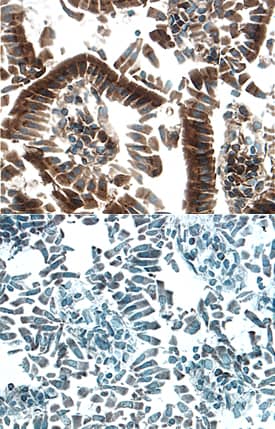Mouse Pro‑HGF Activator Antibody
R&D Systems, part of Bio-Techne | Catalog # AF1715

Key Product Details
Species Reactivity
Applications
Label
Antibody Source
Product Specifications
Immunogen
Gln35-Ser653
Accession # Q9R098
Specificity
Clonality
Host
Isotype
Scientific Data Images for Mouse Pro‑HGF Activator Antibody
HGF Activator in Mouse Intestine.
HGF Activator was detected in perfusion fixed frozen sections of mouse intestine using Goat Anti-Mouse Pro-HGF Activator Antigen Affinity-purified Polyclonal Antibody (Catalog # AF1715) at 15 µg/mL overnight at 4 °C. Tissue was stained using the Anti-Goat HRP-DAB Cell & Tissue Staining Kit (brown; Catalog # CTS008) and counterstained with hematoxylin (blue). Lower panel shows a lack of labeling when primary antibodies are omitted and tissue is stained only with secondary antibody followed by incubation with detection reagents. Specific staining was localized to cytoplasm. View our protocol for Chromogenic IHC Staining of Frozen Tissue Sections.Applications for Mouse Pro‑HGF Activator Antibody
Immunohistochemistry
Sample: Perfusion fixed frozen sections of mouse intestine
Immunoprecipitation
Sample: Conditioned cell culture medium spiked with Recombinant Mouse Pro-HGF Activator, see our available Western blot detection antibodies
Western Blot
Sample: Recombinant Mouse Pro-HGF Activator
Formulation, Preparation, and Storage
Purification
Reconstitution
Formulation
Shipping
Stability & Storage
- 12 months from date of receipt, -20 to -70 °C as supplied.
- 1 month, 2 to 8 °C under sterile conditions after reconstitution.
- 6 months, -20 to -70 °C under sterile conditions after reconstitution.
Background: HGF Activator
Pro-HGF-A (Hepatocyte growth factor activator protein) is a 96 kDa member of the PA-FXII-HGFA family of enzymes. It is secreted by hepatocytes and is found in plasma at approximately 40 nM concentration. Other cells selectively reported to express HGF-A include astrocytes, endothelium, fibroblasts and macrophages. Upon activation, HGF-A is known to activate both proHGF and proMSP via proteolytic cleavage. The circulating 96 kDa form of mouse HGF-A represents an inactive 619 amino acid (aa) proform (aa 35-653). Within this proform exists one FN type II domain (aa 100-147), an EGF-like domain (aa 157-195), an FN type III domain (aa 197‑237), a second EGF-like domain (aa 238-276), a kringle domain (aa 283-364) and a functional peptidase S1 domain (aa 406-644). Activation of HGF-A typically occurs with a thrombin-mediated cleavage between Arg405-Ile406 and a KLK cleavage between Arg369-Val370. This creates a 34 kDa heterodimeric active product that contains a 2 kDa N-terminus (aa 370-405) disulfide linked to a 32 kDa C-terminus (aa 406-653). Once activated, the 34 kDa heterodimer binds to cell surface HAI‑1, rendering it unavailable to circulating HGF. When needed, this HGF-A:HAI-1 complex is released, HGF-A dissociates from HAI-1, and HGF-A is free to activate proHGF. Over aa 35-653, mouse HGF-A shares 92% and 82% aa identity with rat and human HGF-A, respectively.
Long Name
Alternate Names
Gene Symbol
UniProt
Additional HGF Activator Products
Product Documents for Mouse Pro‑HGF Activator Antibody
Product Specific Notices for Mouse Pro‑HGF Activator Antibody
For research use only
